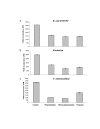Blockade of catecholamine-induced growth by adrenergic and dopaminergic receptor antagonists in Escherichia coli O157:H7, Salmonella enterica and Yersinia enterocolitica
- PMID: 17263883
- PMCID: PMC1800854
- DOI: 10.1186/1471-2180-7-8
Blockade of catecholamine-induced growth by adrenergic and dopaminergic receptor antagonists in Escherichia coli O157:H7, Salmonella enterica and Yersinia enterocolitica
Abstract
Background: The ability of catecholamines to stimulate bacterial growth was first demonstrated just over a decade ago. Little is still known however, concerning the nature of the putative bacterial adrenergic and/or dopaminergic receptor(s) to which catecholamines (norepinephrine, epinephrine and dopamine) may bind and exert their effects, or even whether the binding properties of such a receptor are similar between different species.
Results: Use of specific catecholamine receptor antagonists revealed that only alpha, and not beta, adrenergic antagonists were capable of blocking norepinephrine and epinephrine-induced growth, while antagonism of dopamine-mediated growth was achieved with the use of a dopaminergic antagonist. Both adrenergic and dopaminergic antagonists were highly specific in their mechanism of action, which did not involve blockade of catecholamine-facilitated iron-acquisition. Use of radiolabeled norepinephrine suggested that the adrenergic antagonists could be acting by inhibiting catecholamine uptake.
Conclusion: The present data demonstrates that the ability of a specific pathogen to respond to a particular hormone is dependent upon the host anatomical region in which the pathogen causes disease as well as the neuroanatomical specificity to which production of the particular hormone is restricted; and that both are anatomically coincidental to each other. As such, the present report suggests that pathogens with a high degree of exclusivity to the gastrointestinal tract have evolved response systems to neuroendocrine hormones such as norepinephrine and dopamine, but not epinephrine, which are found with the enteric nervous system.
Figures

Similar articles
-
Specificity of catecholamine-induced growth in Escherichia coli O157:H7, Salmonella enterica and Yersinia enterocolitica.FEMS Microbiol Lett. 2007 Apr;269(2):221-8. doi: 10.1111/j.1574-6968.2006.00619.x. Epub 2007 Jan 11. FEMS Microbiol Lett. 2007. PMID: 17229058
-
Molecular Profiling: Catecholamine Modulation of Gene Expression in Escherichia coli O157:H7 and Salmonella enterica Serovar Typhimurium.Adv Exp Med Biol. 2016;874:167-82. doi: 10.1007/978-3-319-20215-0_7. Adv Exp Med Biol. 2016. PMID: 26589218 Review.
-
Alpha and beta adrenergic receptor involvement in catecholamine-induced growth of gram-negative bacteria.Biochem Biophys Res Commun. 1993 Jan 29;190(2):447-52. doi: 10.1006/bbrc.1993.1068. Biochem Biophys Res Commun. 1993. PMID: 8381276
-
Influence of dietary catechols on the growth of enteropathogenic bacteria.Int J Food Microbiol. 2007 Nov 1;119(3):159-69. doi: 10.1016/j.ijfoodmicro.2007.07.039. Epub 2007 Aug 1. Int J Food Microbiol. 2007. PMID: 17850907
-
Catecholamine receptors and signal transduction. Overview.Adv Pharmacol. 1998;42:379-90. doi: 10.1016/s1054-3589(08)60770-x. Adv Pharmacol. 1998. PMID: 9327921 Review. No abstract available.
Cited by
-
Neuromodulators as Interdomain Signaling Molecules Capable of Occupying Effector Binding Sites in Bacterial Transcription Factors.Int J Mol Sci. 2023 Nov 1;24(21):15863. doi: 10.3390/ijms242115863. Int J Mol Sci. 2023. PMID: 37958845 Free PMC article.
-
The stress hormone norepinephrine increases the growth and virulence of Aeromonas hydrophila.Microbiologyopen. 2019 Apr;8(4):e00664. doi: 10.1002/mbo3.664. Epub 2018 Jun 13. Microbiologyopen. 2019. PMID: 29897673 Free PMC article.
-
Role of Neurochemicals in the Interaction between the Microbiota and the Immune and the Nervous System of the Host Organism.Probiotics Antimicrob Proteins. 2017 Sep;9(3):215-234. doi: 10.1007/s12602-017-9262-1. Probiotics Antimicrob Proteins. 2017. PMID: 28229287 Review.
-
Chemotaxis of Escherichia coli to major hormones and polyamines present in human gut.ISME J. 2018 Nov;12(11):2736-2747. doi: 10.1038/s41396-018-0227-5. Epub 2018 Jul 11. ISME J. 2018. PMID: 29995838 Free PMC article.
-
Communication between Bacteria and Their Hosts.Scientifica (Cairo). 2013;2013:361073. doi: 10.1155/2013/361073. Epub 2013 Dec 8. Scientifica (Cairo). 2013. PMID: 24381789 Free PMC article. Review.
References
-
- Lyte M. The role of microbial endocrinology in infectious disease. J Endocrinol. 1993;137:343–345. - PubMed
Publication types
MeSH terms
Substances
Grants and funding
LinkOut - more resources
Full Text Sources
Other Literature Sources
Research Materials

